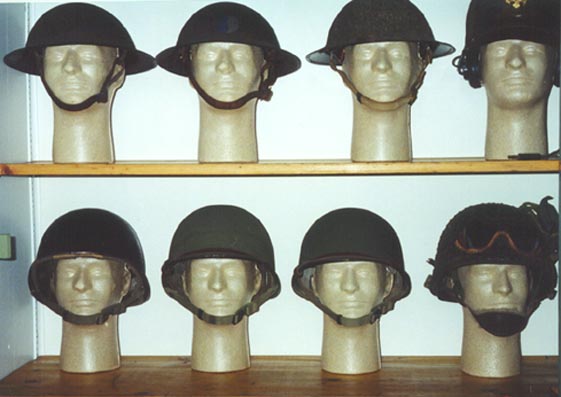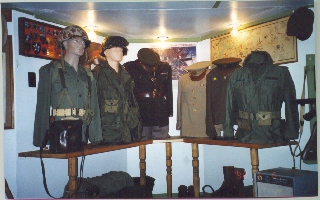
You'll need a helmet. There were two (2) basic types. Fixed or swivel bale. This refers to the type of "ring" that the webbed chinstrap is attached to. Either one is acceptable but you would want the chinstrap to be of khaki or light OD color to be more accurate. Make sure that it has a liner. There are differences in these also, but you'll know that you have one from WWII if it has a grommeted hole in the middle. Steel pots are pretty much readily available.
When your not in the field you'll need a "cover" or hat. There are different types according to the "class" of uniform you are wearing. With fatigues you will need an M-1943 cap which is a baseball type of cotton cap or a wool "jeep" hat for colder weather. Also, you will need an O/S cap with light blue infantry piping. Now, if your head is a normal size you may be able to find originals. I have a big head so I had to buy a reproduction M-1943. I found a 1950 dated O/S cap that fit me and I sewed the blue piping on it. Yeah, I cheated but it looks good and you can't tell the difference.

There were two basic combat styles that were worn. Summer HBT's or winter wools. Let's take a look at the latter. Wool clothing is probably the most recognizable of WWII GI styles. They come in a light OD color. Some shirts had a "gas flap" on the inside. Shirts also had two patch pockets; each with a button-flap. They came in regular shirt sizes. I've never seen anything larger that a 151/2" neck. But fortunately everything made for the armed services was cut big. I normally wear a 17" neck and I have a size 44" chest, but I have a 151/2" shirt which I wear when re-enacting. Although, I do admit it is a bit snug. The pants are sized in waist and length as well and they also come in a light OD color. The have slash pockets and rear pockets on both legs. There is a watch pocket on the right leg. The buttons on the shirt and pants are an OD color and made of plastic. There are many different types of HBT's. They came in coveralls or two pieces made of cotton in a herringbone twill pattern. The most common style worn was a shirt with two patch pockets that each had a button-flap. This shirt also included a "gas flap". The shirts came in chest sizes which were cut big. I would assume they were cut this way so a soldier can fit the HBT shirt over the wool shirt and use it as a jacket. The pants had two cargo pockets on the side of each leg and the rear pockets were omitted. The normal slash pockets were omitted. The buttons were made of metal with 13 stars surrounded by a wreath on the front, which were riveted into the shirt and pants. The color was designated OD#7.
There were many different styles of jackets but I will mention the two most common. The first was the M-1941 pattern. This was a cotton shell, OD color, waist jacket with a by-swing back. There were button tabs on the sleeves by the wrist and on the waist. The jacket had a zipper and a button flap to break the cold. It was lined with an OD wool blanket material and hand warmer pockets on the outside. The M-1941 was replaced by the M-1943 pattern. This was a dark OD green, jacket that extended to the thighs. It had four button-flap pockets and a thick cotton lining on the inside with a pull string around the waist. The jacket was buttoned down (not zipped). It included buttons around the inside of the collar to attach a hood.

Just as there were many different types of clothing there was an assorted amount of footwear as well. I'll describe the two types of combat boots that were worn the most. The first type to be worn was the low quarter boot. This was a capped toed, russet brown boot that was ankle high. Worn over the boot was a pair of canvas leggings. These were attached to the boot by a strap that wrapped underneath the boot around the width of the sole and was thread into a buckle near the in-step. The leggings then covered the ankle by being laced up the side. These were worn through the duration of the war. In 1943 the army began to issue a double buckle combat boot. These were a suede type of leather and were cut similar to the low quarter boot. There was a wide smooth leather piece sewn to the top. These had two straps at one end and two buckles at the other. When attached they wrapped around the ankle. Low quarter boots were also converted into double buckle boots. I have both types.
Over the past couple of years the collecting of WWII GI clothing and gear has become more desirable which of course created a marketable value for many items. Also, most guys who re-enact are not as young as the original GI's therefore large sizes are hard to find. If you are fortunate to find original clothing in a large size you are probably going to pay a good sum for it and your going to want your item in good condition. After the hard work and hard cash you may not want to tear it up re-enacting.
There are a few dealers who sell reproduction GI uniforms, which are pretty close to the originals. Recently I purchased an HBT set. Compared to my original it is pretty close and it fits me like a glove. I also own a pair of repro double buckle boots and a repro M-1941 jacket. I wear my repros when I'm out in the field re-enacting and I wear my originals when we put on a static display for the public. Honestly, the repros cost just as much or more than the originals. I won't feel as bad if I tear a repro as I would the real thing because the original will increase in value and it is an important part of our history.
